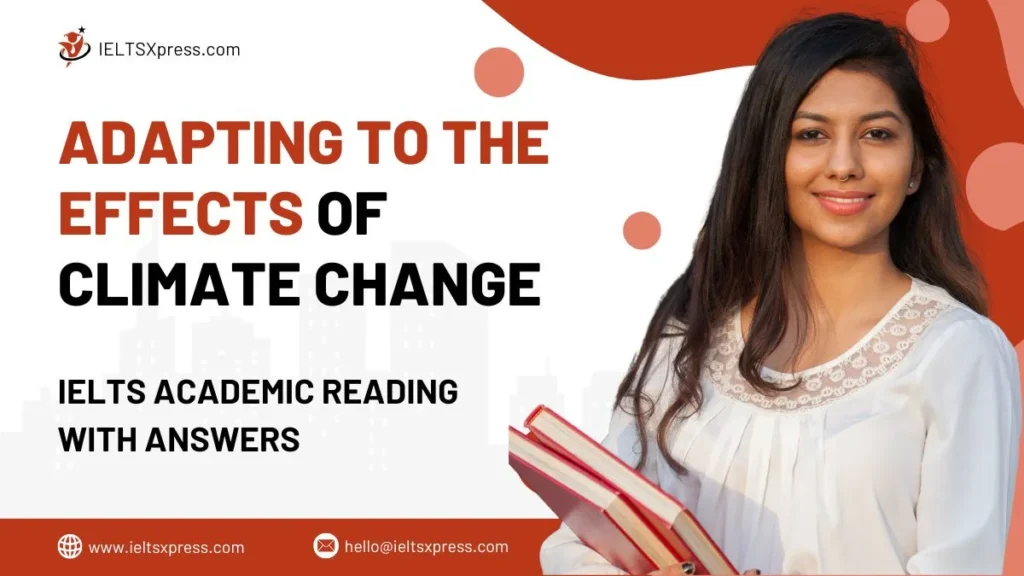Adapting to the Effects of Climate Change IELTS Reading with Answers
Adapting to the Effects of Climate Change IELTS Reading with Answers is a timely and informative passage from the IELTS Academic Reading Test. It explores how communities, governments, and ecosystems are responding to the growing impacts of climate change through adaptation strategies. This passage assesses your ability to understand factual information, evaluate solutions, and follow cause-and-effect relationships.
In this article, you’ll find a full breakdown of the passage, an overview of question types, and accurate answers with explanations to support your IELTS Reading preparation.
READING PASSAGE 2
You should spend about 20 minutes on Question 14-26 which are based on Reading Passage 2 below.
Adapting to the Effects of Climate Change
A. All around the world, nations are already preparing for, and adapting to, climate change and its impacts. Even if we stopped all CO2 emissions tomorrow, we would continue to see the impact of the CO2 already released since industrial times, with scientists forecasting that global warming would continue for around 40 years. In the meantime, ice caps would continue to melt and sea levels rise. Some countries and regions will suffer more extreme impacts from these changes than others. It’s in these places that innovation is thriving.
B. In Miami Beach, Florida, USA, seawater isn’t just breaching the island city’s walls, it’s seeping up through the ground, so the only way to save the city is to lift it up above sea level. Starting in the lowest and most vulnerable neighbourhoods, roads have been raised by as much as 61 centimetres. The elevation work was carried out as part of Miami Beach’s ambitious but much-needed stormwater-management programme. In addition to the road adaptations, the city has set up new pumps that can remove up to 75,000 litres of water per minute. In the face of floods, climate-mitigation strategies have often been overlooked, says Yanira Pineda, a senior sustainability coordinator. She knows that they’re essential and that the job is far from over. ‘We know that in 20, 30, 40 years, we’ll need to go back in there and adjust to the changing environment,” she says.
C. Seawalls are a staple strategy for many coastal communities, but on the soft, muddy northern shores of Java, Indonesia, they frequently collapse, further exacerbating coastal erosion. There have been many attempts to restore the island’s coastal mangroves: ecosystems of trees and shrubs that help defend coastal areas by trapping sediment in their net-like root systems, elevating the sea bed and dampening the energy of waves and tidal currents. But Susanna Tol of the not-for-profit organisation Wetlands International says that, while hugely popular, the majority of mangrove-planting projects fail. So, Wetlands International started out with a different approach, building semi-permeable dams, made from bamboo poles and brushwood, to mimic the role of mangrove roots and create favourable conditions for mangroves to grow back naturally. The programme has seen moderate success, mainly in areas with less subsidence. ‘Unfortunately, traditional infrastructure is often single-solution focused,’ says Tol. ‘For long-term success, it’s critical that we transition towards multifunctional approaches that embed natural processes and that engage and benefit communities and local decision-makers.’
D. As the floodwaters rose in the rice fields of the Mekong Delta in September 2018, four small houses rose with them. Homes in this part of Vietnam are traditionally built on stilts but these ones had been built to float. The modifications were made by the Buoyant Foundation Project, a not-for-profit organisation that has been researching and retrofitting amphibious houses since 2006. ‘When I started this,’ explains founder Elizabeth English, ‘climate change was not on the tip of everybody’s tongue, but this technology is becoming necessary in places that didn’t previously need it.’ It’s much cheaper than permanently elevating houses, English explains – about a third of what it would cost to completely replace a building’s foundations. It also avoids the problem of taller houses being at greater risk from wind damage. Another plus comes from the fact that amphibious structures can be sensitively adapted to meet cultural needs and match the kind of houses that are already common in a community.
E. Bangladesh is especially vulnerable to climate change. Most of the country is less than a metre above sea level and 80 per cent of its land lies on floodplains. ‘Almost 35 million people living on the coastal belt of Bangladesh are currently affected by soil and water salinity,” says Raisa Chowdhury of the international development organisation ICOO Cooperation. Rather than fighting against it, one project is helping communities adapt to salt-affected soils. ICOO Cooperation has been working with 10,000 farmers in Bangladesh to start cultivating naturally salt-tolerant crops in the region. Certain varieties of carrot, potato, kohlrabi, cabbage and beetroot have been found to be better suited to salty soil than the rice and wheat that is typically grown there. Chowdhury says that the results are very visible, comparing a barren plot of land to the ‘beautiful, lush green vegetable garden’ sitting beside it, in which he and his team have been working with the farmers. Since the project began, farmers trained in saline agriculture have reported increases of two to three more harvests per year.
F. Greg Spotts from Los Angeles (LA) in the USA is chief sustainability officer of the city’s street services department. He leads the Cool Streets LA programme, a series of pilot projects, which include the planting of trees and the installation of a ‘cool pavement’ system, designed to help reach the city’s goal of bringing down its average temperature by 1.5°C. ‘Urban cooling is literally a matter of life and death for our future in LA,’ says Spotts. Using a Geographic Information System data mapping tool, the programme identified streets with low tree canopy cover in three of the city’s neighbourhoods and covered them with a light-grey, light-reflecting coating, which had already been shown to lower road surface temperature in Los Angeles by 6°C. Spotts says one of these streets, in the Winnetka neighbourhood of San Fernando Valley, can now be seen as a pale crescent, the only cool spot on an otherwise red thermal image, from the International Space Station.
Questions 14–17
Reading Passage 2 has six paragraphs, A–F.
Which paragraph contains the following information?
Write the correct letter, A–F, in boxes 14–17 on your answer sheet.
14. how a type of plant functions as a natural protection for coastlines
15. a prediction about how long it could take to stop noticing the effects of climate change
16. a reference to the fact that a solution is particularly cost-effective
17. a mention of a technology used to locate areas most in need of intervention
Questions 18-22
Complete the sentences below.
Choose ONE WORD ONLY from the passage for each answer.
Write your answers in boxes 18-22 on your answer sheet.
18 The stormwater-management programme in Miami Beach has involved the installation of efficient________
19 The construction of ________ was the first stage of a project to ensure the success of mangroves in Indonesia.
20 As a response to rising floodwaters in the Mekong Delta, a not-for-profit organisation has been building houses that can ________.
21 Rising sea levels in Bangladesh have made it necessary to introduce various ________ that are suitable for areas of high salt content.
22 A project in LA has increased the number of ________ on the city’s streets.
Questions 23-26
Look at the following statements (Questions 23-26) and the list of people below.
Match each statement with the correct person,
Write the correct letter, A H, in boxes 23-26 on your answer sheet.
23 It is essential to adopt strategies which involve and help residents of the region.
24 Interventions which reduce heat are absolutely vital for our survival in this location.
25 More work will need to be done in future decades to deal with the impact of rising water levels.
26 The number of locations requiring action to adapt to flooding has grown in recent years.
List of People
A. Yanira Pineda
B. Susanna Tol
C. Elizabeth English
D. Raisa Chowdhury
E. Greg Spotts
Adapting to the Effects of Climate Change Reading Answers
14. C
15. A
16. D
17. F
18. Pumps
19. Dams
20. Float
21. Crops
22. Trees
23. B
24. E
25. A
26. C
Also Practice: The Life and Work of Georgia O Keeffe IELTS Reading with Answers



